Introduction
ISO 9001 is the international standard for Quality Management Systems (QMS), recognized and utilized by organizations worldwide to ensure they meet the needs of customers and other stakeholders while complying with statutory and regulatory requirements. The ISO 9001 standard provides a framework for businesses to streamline their processes, enhance operational efficiency, and improve product and service quality. This certification is applicable to any organization, regardless of size, industry, or nature of business, making it a versatile and essential tool for quality assurance. This article delves into the key requirements of ISO 9001, the benefits of implementing these requirements, the challenges organizations might face, and strategies to effectively implement ISO 9001 standards.
Key Requirements of ISO 9001
ISO 9001 is structured around a series of requirements that collectively ensure a robust Quality Management System. These requirements are categorized into several main clauses, each addressing different aspects of quality management and operational efficiency.
Context of the Organization
The first major requirement of ISO 9001 involves understanding the context of the organization. This entails identifying internal and external factors that can impact the organization's ability to achieve its intended outcomes. Organizations must determine the relevant interested parties, such as customers, suppliers, and regulatory bodies, and understand their needs and expectations. This contextual understanding helps in defining the scope of the QMS and setting its boundaries. It also involves identifying risks and opportunities that could affect the QMS, allowing organizations to plan and implement strategies to mitigate risks and capitalize on opportunities.
Leadership
Leadership is a critical component of ISO 9001, emphasizing the role of top management in establishing and maintaining a quality-focused culture. Top management must demonstrate leadership and commitment by actively engaging in the QMS and ensuring its alignment with the organization’s strategic direction. This includes setting quality policies and objectives, allocating resources, and promoting continuous improvement. Leadership also involves assigning roles, responsibilities, and authorities to ensure that everyone in the organization understands their role in achieving quality objectives. Effective leadership fosters a culture of quality and empowers employees to contribute to the QMS.
Planning
Planning is an essential requirement of ISO 9001, involving the development of strategies to achieve quality objectives and address risks and opportunities. Organizations must establish quality objectives that are consistent with the quality policy, measurable, and aligned with the organization’s strategic goals. Planning also includes determining the actions required to address risks and opportunities, integrating these actions into the QMS processes, and evaluating their effectiveness. Additionally, planning involves managing changes to the QMS in a controlled manner to ensure that quality is maintained during transitions. By effectively planning, organizations can proactively address potential issues and ensure the successful implementation of the QMS.
Support
Support requirements focus on providing the necessary resources, competence, awareness, communication, and documented information to implement and maintain the QMS. Organizations must ensure that they have the adequate resources, such as personnel, infrastructure, and a suitable work environment, to achieve quality objectives. Competence involves ensuring that employees have the necessary skills, training, and experience to perform their roles effectively. Awareness requires that employees understand the quality policy, their contribution to the QMS, and the implications of not conforming to the QMS requirements. Effective communication ensures that relevant information is communicated within the organization and to external parties. Finally, organizations must establish and maintain documented information to support the QMS, including creating, updating, and controlling documents and records.
Benefits of Implementing ISO 9001 Requirements
Implementing ISO 9001 requirements offers numerous benefits to organizations, enhancing their operations, customer satisfaction, and overall performance.
Improved Operational Efficiency
One of the primary benefits of ISO 9001 is the improvement in operational efficiency. The standard provides a structured framework for identifying inefficiencies and streamlining processes. By adopting a systematic approach to quality management, organizations can reduce waste, minimize errors, and optimize resource utilization. This leads to cost savings, increased productivity, and more efficient operations. The focus on continuous improvement ensures that organizations regularly evaluate and enhance their processes, leading to sustained operational excellence.
Enhanced Customer Satisfaction
Customer satisfaction is a core focus of ISO 9001, and implementing the standard helps organizations consistently meet or exceed customer expectations. The standard requires organizations to understand customer needs, monitor customer satisfaction, and take corrective actions to address issues. By delivering high-quality products and services, organizations can build strong customer relationships and foster loyalty. Improved customer satisfaction also leads to positive word-of-mouth and repeat business, contributing to long-term success. Additionally, ISO 9001 certification can enhance the organization’s reputation, as customers often view it as a mark of quality and reliability.
Increased Market Opportunities
ISO 9001 certification opens up new market opportunities by demonstrating an organization’s commitment to quality and continuous improvement. Many clients, especially in international markets, require their suppliers to be ISO 9001 certified. By achieving certification, organizations can access these markets and meet the expectations of global customers. The certification also provides a competitive advantage, differentiating the organization from competitors who may not be certified. This can lead to increased business opportunities, partnerships, and revenue growth.
Better Risk Management
Effective risk management is a crucial benefit of implementing ISO 9001. The standard requires organizations to identify and address risks and opportunities that could impact the QMS. By proactively managing risks, organizations can prevent potential issues from arising and mitigate their impact. This leads to more stable and predictable operations, reducing the likelihood of disruptions and enhancing resilience. The focus on risk-based thinking ensures that organizations are prepared to handle uncertainties and adapt to changing circumstances. Better risk management also contributes to improved decision-making and strategic planning.
Challenges in Implementing ISO 9001 Requirements
While the benefits of ISO 9001 are significant, organizations may encounter several challenges during the implementation process.
Resource Allocation
One of the main challenges is allocating sufficient resources for the implementation and maintenance of the QMS. ISO 9001 requires organizations to invest in training, infrastructure, and documentation, which can be resource-intensive. Smaller organizations, in particular, may struggle with the financial and personnel resources needed to achieve and maintain certification. Ensuring that the necessary resources are available and effectively utilized is crucial for the successful implementation of ISO 9001 requirements.
Change Management
Implementing ISO 9001 often requires significant changes to existing processes and practices. Managing these changes can be challenging, especially if there is resistance from employees. Effective change management involves clear communication, employee involvement, and addressing concerns and resistance. Organizations must foster a culture of quality and continuous improvement, where employees understand the benefits of ISO 9001 and are motivated to contribute to its success. Providing training and support to employees during the transition can help alleviate resistance and ensure smooth implementation.
Documentation and Record-Keeping
ISO 9001 requires extensive documentation and record-keeping, which can be time-consuming and complex. Organizations must establish and maintain documented information to support the QMS, including procedures, records, and evidence of compliance. Ensuring that documentation is accurate, up-to-date, and easily accessible is crucial for audits and inspections. Organizations may need to invest in robust documentation systems and processes to manage this requirement effectively. Additionally, maintaining documentation can be an ongoing challenge, requiring regular reviews and updates.
Continuous Improvement
ISO 9001 emphasizes continuous improvement, requiring organizations to regularly evaluate and enhance their processes. Sustaining a culture of continuous improvement can be challenging, as it requires ongoing commitment and effort from all levels of the organization. Organizations must establish mechanisms for monitoring performance, identifying areas for improvement, and implementing corrective actions. This involves regular internal audits, management reviews, and feedback loops. Encouraging employee involvement and fostering a mindset of innovation and improvement are essential for sustaining continuous improvement.
Strategies for Effective Implementation of ISO 9001
Implementing ISO 9001 requirements effectively requires a strategic approach and careful planning. Organizations can adopt several strategies to ensure successful implementation and reap the benefits of ISO 9001 certification.
Top Management Commitment
The commitment of top management is crucial for the successful implementation of ISO 9001. Leadership must actively support and participate in the QMS, demonstrating their commitment to quality and continuous improvement. This includes setting clear quality policies and objectives, allocating necessary resources, and fostering a culture of quality throughout the organization. Top management should communicate the importance of ISO 9001 to all employees and ensure that everyone understands their role in achieving quality objectives. By leading by example, top management can drive the successful implementation of ISO 9001 requirements.
Employee Involvement and Training
Employee involvement and training are essential for effective implementation. Employees at all levels must understand the requirements of ISO 9001 and their role in the QMS. Providing training and development opportunities can enhance employee competence and ensure that they have the necessary skills to perform their roles effectively. Involving employees in the development and implementation of the QMS can also foster ownership and commitment. Organizations should create opportunities for employees to contribute their ideas and feedback, encouraging a culture of continuous improvement.
Robust Documentation and Record-Keeping
Establishing robust documentation and record-keeping systems is crucial for meeting ISO 9001 requirements. Organizations should develop clear and comprehensive procedures for creating, updating, and controlling documentation. This includes maintaining accurate records of processes, procedures, and evidence of compliance. Utilizing digital tools and document management systems can streamline documentation and ensure easy access to information. Regular reviews and audits of documentation can help identify gaps and ensure that records are up-to-date and accurate.
Continuous Monitoring and Improvement
Continuous monitoring and improvement are key components of ISO 9001. Organizations should establish mechanisms for regularly evaluating performance, identifying areas for improvement, and implementing corrective actions. This involves conducting internal audits, management reviews, and feedback loops. Organizations should also establish key performance indicators (KPIs) to measure progress towards quality objectives. By fostering a culture of continuous improvement, organizations can ensure that their QMS remains effective and aligned with their strategic goals.
Conclusion
ISO 9001 requirements is a powerful tool for enhancing quality management and operational efficiency within organizations. By understanding and implementing the key requirements of ISO 9001, organizations can improve their processes, enhance customer satisfaction,







